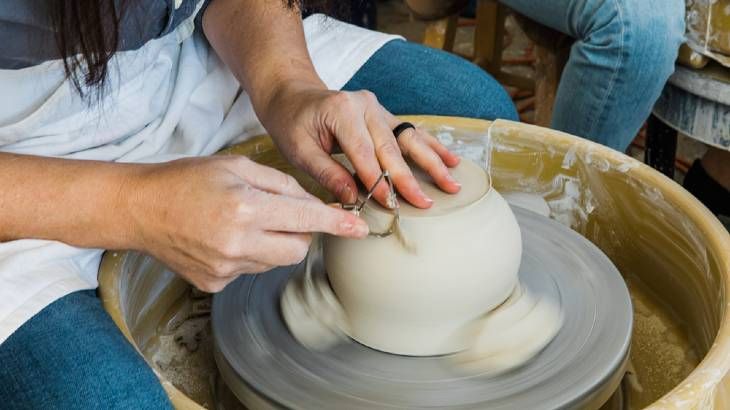Where Do We Get Clay Soil From?
Clay soil is a finely-grained earth material containing very small mineral particles. It develops from the natural breakdown of rocks over long periods of time through weathering and erosion. Clay particles are less than 0.002 mm in diameter, which gives clay its smooth texture and ability to retain moisture. Clay soil is an important material for things like pottery, bricks, and agriculture. Understanding where clay comes from helps explain its unique properties and why clay deposits can be found across the world.
Clay Formation
Clay forms from the chemical weathering and breakdown of rocks over long periods of time. The parent material for clay includes igneous, metamorphic and sedimentary rocks. As these rocks are exposed to weathering processes like rain, wind, freezing temperatures, and plant growth, the minerals within the rocks begin to chemically decompose. The main ingredients in the formation of clay are the minerals feldspar and mica. Feldspar is abundant in granitic rocks and slowly breaks down into clay minerals when exposed to carbonic acid from rainwater and humic acids from decaying plant matter. Similarly, mica which contains iron, magnesium, potassium, also weathers into clay sized particles. The chemical decomposition causes the minerals to disintegrate and leach away, leaving behind clay sized particles less than .002 mm in size.
In addition to chemical weathering, physical weathering helps break down rocks into smaller particles. As rocks expand and contract due to temperature changes, freeze-thaw cycles, and plant growth, the rocks fracture and crumble. Glaciers and rivers also grind rocks into finer grains. Over time, all these chemical and physical weathering processes act together to transform rocks into clay.
Parent Material
Clay originates from the gradual chemical weathering and decomposition of rocks over long periods of time. The specific parent rocks that clay forms from are known as the “parent material.” These parent rocks need to contain a high percentage of silica, alumina, and/or magnesium to produce clay.
The most common parent rocks that produce clay include feldspar-rich igneous rocks like granite, rhyolite and pegmatite. Sedimentary rocks can also be parent materials for clay if they contain enough feldspar minerals. Examples include arkose sandstone and greywacke sandstone. Additionally, mafic igneous rocks like basalt and gabbro can weather into clay, although this process is slower than more felsic igneous rocks.
Regardless of the exact parent material, the essential process is the chemical weathering and decomposition of silicate minerals within the rocks. As they break down, components like potassium, sodium, and calcium are leached away. What’s left behind are aluminum and silicon oxides which will combine with water to form clays.
Chemical Weathering
Chemical weathering is the process by which rocks break down through chemical reactions. This usually involves water, air, acids, and organic matter interacting with rock minerals. There are several chemical weathering processes that create clay minerals:
– Hydrolysis – minerals react with water molecules and are altered into clays. For example, feldspar (an aluminum silicate) is hydrolyzed and forms kaolinite clay.
– Chelation – organic acids produced by plants and microbes react with minerals, breaking them down into clays. The organic acids “grab on” to cations like calcium, iron, and aluminum, separating them from their parent minerals.
– Acidolysis – acids like sulfuric acid and nitric acid penetrate rocks and cause chemical weathering reactions. Sulfuric acid can react with feldspar, forming kaolinite clay.
– Oxidation – exposure to oxygen can cause minerals like pyrite to break down into oxides and clays. The oxidation of pyrite forms sulfuric acid which enables acidolysis.
– Carbonation – carbon dioxide reacts with minerals containing calcium, magnesium, and iron to form soluble bicarbonates. As these dissolve, silica and aluminum oxides persist and develop into clays.
These chemical processes gradually decompose the parent rocks and minerals, transforming them into clay particles and releasing elements like potassium, calcium, and magnesium into the environment.
Physical Weathering
Physical or mechanical weathering involves the breakdown of rocks into smaller pieces without any chemical changes to the minerals in the rocks. This type of weathering can happen through processes like frost action, salt weathering, and plant roots growing into cracks and forcing the rocks apart. Frost action occurs when water seeps into cracks in rocks, expands as it freezes, and then forces the cracks to widen when the ice thaws. Over many freeze/thaw cycles, rocks can break down into smaller fragments. Salt weathering happens in arid environments when water containing dissolved salts seeps into rock pores. As the water evaporates, the salt precipitates out and expands, exerting pressure that can break apart rocks. Plant roots are also powerful physical weathering agents as they grow into fractures and pry rocks apart little by little. All of these mechanical processes gradually transform large rock formations into smaller particles like gravel, sand, silt, and clay.
Climate and Clay
Climate has a significant impact on clay formation rates and properties. Areas with warm, wet climates tend to have higher clay formation rates because the abundant moisture and heat accelerates chemical weathering. In tropical rainforests like the Amazon, for example, intense rainfall rapidly breaks down feldspar and other minerals into clay particles.
Cooler, drier climates lead to slower clay production since there is less liquid water available to drive chemical reactions. Arid deserts like the Sahara have minimal clay deposits due to the lack of rainfall.
Climate also affects clay composition. In warm, moist environments, clays tend to be dominated by kaolinite and iron oxides. In cold regions, illite and smectite clays are more prevalent. The speed of clay formation impacts crystallinity as well. Fast tropical weathering yields smaller, more disordered kaolinite crystals while slow northerly weathering allows larger illite and smectite crystals to form.
Additionally, cycles of freezing and thawing in cold climates contribute to mechanical weathering, breaking down rock physically into smaller particles. The intense physical forces of expansion, contraction, and fracturing generated through freeze-thaw cycles accelerate the release of clay particles from source rocks.
Clay Deposits
Clay deposits can be found all over the world, but some regions contain more abundant or higher quality deposits than others. Some of the major clay deposits are located:
-
In the central and southeastern United States, which contains rich deposits of kaolin clay. Major kaolin mining operations are found in Georgia, South Carolina, and Florida.
-
In the upper Midwestern states like Minnesota, Wisconsin, Iowa, and Illinois, which have plentiful glacial and lacustrine clay deposits.
-
In the Mississippi River Delta region, which contains smectite clay deposits ideal for drilling mud.
-
In central and western Texas and Oklahoma, home to extensive bentonite clay beds.
-
In the Pacific Northwest states of Oregon and Washington, which have marine clay deposits.
-
In the St. Lawrence Lowlands of Quebec, Canada which holds enormous marine clay beds.
-
In the Amazon River Basin, which contains large kaolinite deposits.
-
In central and northern Europe countries like Germany, France, and the UK, which have widespread glacial clay deposits.
-
In Russia and Ukraine, which contain very pure kaolin reserves.
-
In China, which produces enormous quantities of kaolin and other clays.
-
In India, which also has abundant clay deposits suitable for ceramics and construction.
-
In Australia, Africa, and South America, which hold significant kaolin, bentonite, and smectite reserves.
So while clay can form anywhere, through weathering processes, certain regions of the world contain the highest quality and volume of clay deposits due to their specific geologic history, climate, and landforms. The leading clay producing countries today include the United States, China, Germany, India, Brazil, Turkey, and others with major clay formations.
Marine Clay Deposits
Marine clay deposits form in ocean and coastal areas from the accumulation of fine-grained clay particles transported by rivers and streams. As river water reaches the ocean, its velocity decreases dramatically, allowing the finest suspended clay particles to settle out of the water column and accumulate on the seafloor.
Over time, these deposits can build up to substantial thicknesses. The constant reworking of seafloor sediments by waves and currents helps to further sort the particles by size, concentrating the clay fraction. Significant marine clay deposits are found in many continental shelf regions around the world.
Estuaries, coastal lagoons, tidal flats and shorelines with soft sediment accumulation are other marine and coastal environments where clay deposits form. Here, fluctuating current velocities encourage deposition and prevent coarser particles from settling. Organic matter from coastal vegetation also helps bind and stabilize the clay.
Types of Clay
There are three major groups of clay minerals that make up most of the clay found in soils: kaolinite, montmorillonite-smectite, and illite.
Kaolinite is the most abundant clay mineral found in soils. It forms by extensive chemical weathering in tropical climates where high rainfall leaches most dissolved material from soils. Kaolinite particles bind tightly together and do not swell in water.
Smectite clays like montmorillonite have weakly bound layers that swell greatly in water, allowing water and ions to move between the layers. They are commonly formed in arid environments from weathered volcanic ash. Smectite clays give soils plasticity and high cation exchange capacity.
Illite clays have potassium ions between some of their layers, making their structure more rigid. Illite forms in hydrothermal alteration of other clays and provides good nutrient retention in soils.
Conclusion
In summary, we have seen that clay originates from the chemical weathering of rocks, particularly igneous and metamorphic rocks containing minerals like feldspar, mica, and illite. The weathering process breaks down these minerals into clay particles over long periods of time. Physical weathering through actions like freezing, thawing, and water erosion also plays a key role in liberating clay particles from bedrock. The climate largely determines the rate of weathering and clay formation, with warm and humid conditions accelerating the process. Deposits of clay can be found across the world, with notable reserves in places like the Amazon basin, China, and Russia. Marine clay deposits formed on ancient seabeds are also an important source. Understanding where clay comes from helps us locate clay resources and make use of this versatile material in products ranging from bricks to medicines. Recognizing the slow geologic processes that create clays also provides perspective on the age of our planet.



